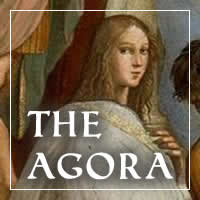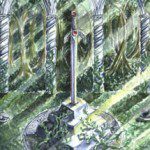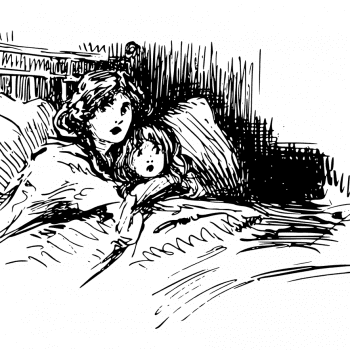[This post has been updated to include a link to other reviews of The Hand on the Mirror elsewhere within the Patheos channels.]
In The Hand on the Mirror, Janis Heaphy Durham shares with us her account of an extraordinary journey that she embarked upon following the death of her first husband, Max, in May of 2004. On the first anniversary of his death, Janis encountered–for the first time, but not the last–a handprint on the mirror in the bathroom used by Max prior to his passing.

Before I continue, I think it’s worthwhile to make something clear: I believe in ghosts.
I can’t say for sure, but I suspect that this isn’t too radical a statement within the Pagan community. We have a variety of traditions that honor and revere our ancestors–both of blood and of spirit–in a vast number of ways. The lore around the commonly celebrated holiday of Samhain includes the belief that the veil between the living and the dead grows thin and we can interact more freely with those who have passed on at that time. Furthermore, many of us believe in a plurality non-corporeal entities (for lack of a simpler term) including nature spirits, genius loci, various gods and goddesses, and probably more.
In other words, even prior to picking up this book, I was inclined to trust in the author’s experience. But, years in the journalism industry provided her with an innate understanding of the skepticism her claims were going to create. As such, the author is meticulous in establishing her own the credentials and those of others with which she meets during the course of her investigation into the handprint on the mirror.
This begins with a chapter devoted to her own history and that of her family. She presents her accomplishments dispassionately; she’s not trying to impress the reader. Her goal is to establish the fact that she’s neither easily dismissed as gullible nor can she be simply ignored as grief stricken. Lending additional credence to this, she’s not the only person to experience the phenomena that she discusses in her memoir. In addition to her son, her second husband, Jim, also shares some of her experiences and much of her research and travel throughout the United States to meet with researchers in fields stretching from psychology to cognitive science, from telecommunications to paranormal investigations.
For each of these, she provides a summary of their credentials discussing their education and work history and, in many cases, how they came to be involved in their current line of work and how that work relates to her research. Similar to her own biography, these are starkly written not to aggrandize those she met with but to further cement in the reader a sense that not only is she credible but those she’s working with are experts in their fields. These curriculum vitae additionally help to show the reader that the belief in extraordinary phenomena (I, personally, avoid the use of “supernatural” or “paranormal” when I can) can be held along side advanced degrees, scientific acumen, and even–in one case–military service.
The phenomena she describes are fairly commonplace for a “ghost story.” In addition to the handprint on the mirror–which reappears on subsequent anniversaries of Max’s death–she also encounters other phenomena including, chiefly, electrical disturbances and the movement of rugs across the floor. Sensationalism sells, and had the author wanted to craft a chilling tale of contact from The Beyond, she certainly could have fabricated more thrilling experiences to share with us, the readers. Hell, I’ve heard better yarns from distant relatives around my parent’s dinning room table.

Photo © Sigrid Estrada
Used with permission
But, The Hand on the Mirror, is not that sort of tale. The author’s goal is not merely to entertain–though she does that quite well–but to share her journey from skepticism to believer. In that way, her story could be considered one of conversion; not of a religious point of view, but still one that rocks the author to her core. And, one that feels familiar to me, and perhaps to others who’ve undertaken a journey of such personal magnitude.
One of the things I found most fascinating was the author’s lack of familiarity with the stories of others who’ve had similar experiences. At one point in the book, she describes the full realization that others–perhaps many others–have experienced similar extraordinary moments in their lives as follows:
“I had lived these past years with a subtle but nagging fear that my exposure to these stunning occurrences meant that somehow I wasn’t ‘normal.’ Because the events were so strange, I initially stayed quiet. Eventually I shared my experiences, but I was selective in whom I chose to speak with. Bottom line, I didn’t want people to think I was nuts. If they did, it might mean that, yes–I was nuts. But now, for the first time, I had confirmation that I wasn’t unusual. In fact, I was normal.
— Janis Heaphy Durham, The Hand on the Mirror, p. 166
Because of my own biases, I’ve been drawn to everything from ghost hunting on reality TV to horror movies to other personal accounts typically more sensational than this one. I’ve even been on a few paranormal investigations, though none of them ever resulted in anything like the experiences touched on in this book or in other more fantastic sources. Thus, it was surprising and somewhat exciting to me to read the account of a person who was not inclined to see such tales as possible.
Even more gratifying was the conclusion she reached:
“I realized […] that it was time for me to start talking openly, without shame or embarrassment. From this point forward, I vowed to myself, I would open up not only to those I was interviewing for my research, but to my family and friends as well. […] It was a breakthrough. I felt free. Liberated. Unshackled.”
— Janis Heaphy Durham, The Hand on the Mirror, p. 167
And, this if nothing else, helps to convince me that her story has been shared with little to embellish it. She writes with an easy, approachable style. She’s not trying to tell a story for the ages, she’s telling her own story for those who are interested in hearing it. And, she does so with little pomp and circumstance; a style which creates not a dry, boring tale (as it could have been), but rather one that allows the reader to get a sense of her own emotional and intellectual state within it. In fact, in some ways, it reads more like a travel log than a ghost story striking the perfect tone to further enhance both the author’s credibility and believability.
The Hand on the Mirror is a tale of personal change wrought in the aftermath of personal tragedy. We are transported along with the author on her travels–physical, intellectual, and emotional–as she seeks to accept and understand the phenomena that she, and those around her, are experiencing. Accompanied by a limited number of photographs of these phenomena–including the handprints–Janis Heaphy Durham shares with us a deeply personal account of her life and does so in a way that found this reader nodding his head rather than shaking it.
It’s available now in print and online. Others here at Patheos have also reviewed this book. You can read their thoughts here; just look for the “Book Roundtable” heading and you’ll find them there.

Patheos Pagan on Facebook.

the Agora on Facebook
David Dashifen Kees is the editor of the Agora and infrequently commits a gross misuse of his powers to write an article or two.
Please use the links to the right to keep on top of activities here on the Agora as well as across the entire Patheos Pagan channel.













